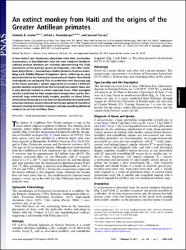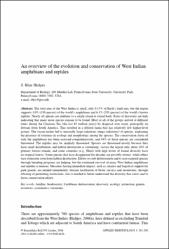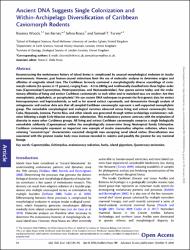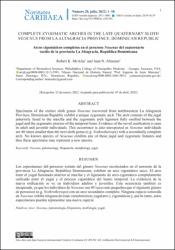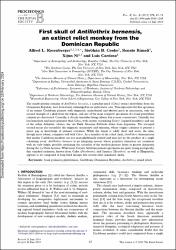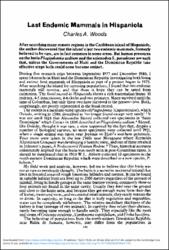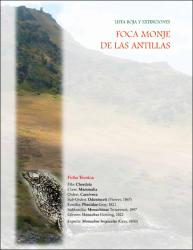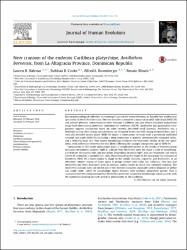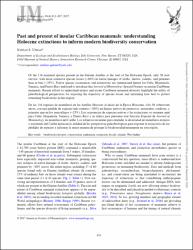Browsing Comunidad Técnico-profesional y científica by Subject "Especies extintas"
Now showing items 1-20 of 27
-
A new fossil raptor (Accipitridae: Buteogallus) from Quaternary cave deposits in Cuba and Hispaniola, West Indies
(2021)A large, extinct species of Buteogallus Lesson is described from post-cranial elements in Quaternary cave deposits in western Cuba and south-central Hispaniola. The new taxon was approximately the same size as females of ... -
A new megalonychid sloth from the late Wisconsinan of the Dominican Republic
(2002)An unusually well preserved skull, mandible, and indisputably associated post-cranial elements of new sloth, Acratocnus (Miocnus), were recovered from a cave in Jaragua National Park, Dominican Republic. The animal died ... -
A new species of extinct Late Quaternary giant tortoise from Hispaniola
(2017)Insular giant tortoise diversity has been depleted by Late Quaternary extinctions, but the taxonomic status of many extinct populations remains poorly understood due to limited available fossil or subfossil material, ... -
An extinct monkey from Haiti and the origins of the Greater Antillean primates
(2011)A new extinct Late Quaternary platyrrhine from Haiti, Insulacebus toussaintiana, is described here from the most complete Caribbean subfossil primate dentition yet recorded, demonstrating the likely coexistence of two ... -
An overview of the evolution and conservation of West Indian amphibians and reptiles
(2006)The total area of the West Indies is small, only 0.15% of Earth’s land area, but the region supports 3.0% (180 species) of the world’s amphibians and 6.3% (520 species) of the world’s known reptiles. Nearly all species are ... -
Ancient DNA suggests single colonization and within-archipelago diversification of Caribbean caviomorph rodents
(2021)Reconstructing the evolutionary history of island biotas is complicated by unusual morphological evolution in insular environments. However, past human-caused extinctions limit the use of molecular analyses to determine ... -
Collagen sequence analysis reveals evolutionary history of extinct West Indies Nesophontes (island-shrews)
(2020)Ancient biomolecule analyses are proving increasingly useful in the study of evolutionary patterns, including extinct organisms. Proteomic sequencing techniques complement genomic approaches, having the potential to examine ... -
Complete zygomatic arches in the Late Quaternary sloth Neocnus from La Altagracia province, Dominican Republic
(2022)[English] Specimens of the extinct sloth genus Neocnus recovered from northwestern La Altagracia Province, Dominican Republic exhibit a unique zygomatic arch. The arch consists of the jugal anteriorly fused to the maxilla ... -
Diving for monkeys
(2012)From deep in the pools of Caribbean caves, CUNY Graduate Center anthropologists retrieve the remains of a long extinct primate and other prize fossils -
Endemic rodents of Hispaniola : biogeography and extinction timing during the Holocene
(2022)Highlights: - Nearly 70% of extinct native rodents from Hispaniola survived until the Late Holocene. - Body size of native rodents does not correlate with extinction timing. - Defaunation postdated climatic changes in the ... -
Estado de la biodiversidad en la República Dominicana II
(2006)Biodiversidad amenazada de la República Dominicana: especies botánicas amenazadas; plantas extintas; especies animales amenazadas; animales extintos. -
Extinction and biogeography in the Caribbean : new evidence from a fossil riodinid butterfly in Dominican amber
(2004)We describe a new species of extinct riodinid butterfly, Voltinia dramba, from Oligo-Miocene Dominican amber (15-25 Myr ago). This appears to be the first butterfly to be taxonomically described from amber, and the first ... -
First skull of Antillothrix bernensis, an extinct relict monkey from the Dominican Republic
(2011)The nearly pristine remains of Antillothrix bernensis, a capuchin-sized (Cebus) extinct platyrrhine from the Dominican Republic, have been found submerged in an underwater cave. This represents the first specimen of an ... -
Last endemic mammals in Hispaniola
(1981)After searching many remote regions in the Caribbean island of Hispaniola, the author discovered that the island's last two endemic mammals, formerly believed to be rare, are in fact common in some areas. But human pressures ... -
Last search for the Jamaican Golden Swallow (Tachycineta e. euchrysea)
(2017)Abstract: The Golden Swallow (Tachycineta euchrysea) is an aerial insectivore and obligate secondary cavity nester endemic to the Caribbean islands of Jamaica and Hispaniola. The declining Hispaniolan subspecies (T. e. ... -
Lista Roja y extinciones : la foca monje
(2011)La foca monje del Caribe fue formalmente declarada extinta en 1996, en la Lista Roja de Animales Amenazados de la UICN. La última vez que se vio fue en 1952, en el Banco Seranilla, entre Jamaica y Honduras, donde se sabía ... -
New cranium of the endemic Caribbean platyrrhine, Antillothrix bernensis, from La Altagracia province, Dominican Republic
(2017)Recent paleontological collection in submerged caves in the eastern Dominican Republic has yielded new specimens of Antillothrix bernensis. Here we describe a complete cranium of an adult individual (MHD 20) and provide ... -
New megalonychid sloths (Phyllophaga, Xenarthra) from the Quaternary of Hispaniola
(2000)As part of ongoing revisionary work on Antillean Megalonychidae, we document four new sloth species from Quaternary cave localities in Haiti and the Dominican Republic. -
New specimens of late Quaternary extinct mammals from caves in Sánchez Ramírez Province, Dominican Republic
(2000)During the late Quaternary, the island of Hispaniola supported one of the most diverse mammalian faunas in the West Indies. Much of this diversity was lost to extinction in the past 100,000 years, but the timing of these ... -
Past and present of insular Caribbean mammals : understanding Holocene extinctions to inform modern biodiversity conservation
(2017)[English] Of the 116 mammal species present in the Greater Antilles at the start of the Holocene Epoch, only 56 now survive, with more extensive species losses (~80%) in native lineages of sloths, shrews, rodents, and ...




